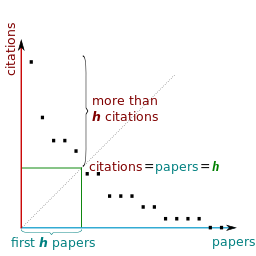The h-index is an index that attempts to measure a researcher's academic production and impact (citations) in one measurement.
A h-index of h, means that you have h publications have been cited at least h times.
You can easily calculate your h-index by ranking your publications according to falling number of citations and gaging how many publications (h) have a minimum of h citations.

Different h-indexes
The h-index is based on a researcher's most cited publications and may vary depending on which source is being used for the calculation.
You can calculate the h-index in the citation databases Scopus (Elsevier) and Web of Science (Thomson Reuters). Moreover, Anne-Wil Harzing's Publish or perish provides the basis for how the calculation can be made by means of Google Scholar.
The citation databases and Google Scholar cover varying publications, and citation figures will therefore vary across databases. There can thus exist different h-indexes for the same person depending on which source is being used.
The size of a h-index also varies greatly across disciplines, and is influenced by how many years a researcher has published actively. Moreover, the h-index does not always behave consistently, when you rank researchers. Thus, it is often difficult to compare researchers using h-index.
Despite this the h-index is frequently used as an alternative to traditional methods, which typically focus on either productivity or influence in the form of citations.

